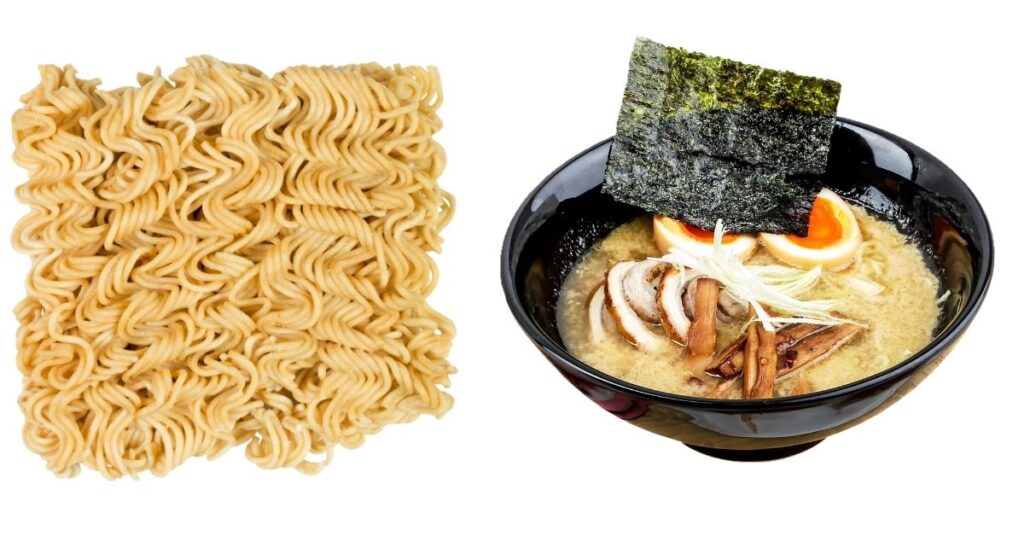Instant ramen noodles can last 6-12 months past the “best by” date if stored properly.
How Long Will Ramen Noodles Last?
Let’s be honest, instant ramen noodles are a lifesaver. Quick, tasty, and oh-so-satisfying, there’s always a ramen packet lurking in our pantries. But as they gather dust, one question nags at us: how long will ramen noodles last? Don’t worry, I’m here to spill the beans.
Types of Ramen: The Key to Longevity
Before we answer the question, we need to understand that ramen comes in different forms:
- Instant Ramen: The classic – dry, pre-cooked noodles with a seasoning packet. These are the pantry staples.
- Fresh Ramen: Found in the refrigerated section, these noodles have a shorter lifespan but offer a more authentic noodle experience.
Instant Ramen: Surprisingly Durable
Instant ramen noodles have a surprisingly long shelf life, typically 6-12 months beyond the “best by” date. This extended shelf life is due to several factors:
- Low Moisture: The noodles are dehydrated, limiting the growth of bacteria and mold.
- Preservatives: Manufacturers may add preservatives and antioxidants to extend the lifespan further.
- Packaging: The airtight packaging helps prevent spoilage.
But What About the Flavor?
While instant ramen noodles can last past their expiration date, that doesn’t guarantee they’ll taste the same. The following happens over time:
- Rancid Oil: The seasoning packet contains oil, which can go bad over time, giving the noodles an unpleasant flavor.
- Stale Noodles: The noodles themselves might lose their texture and become less satisfying to eat.
How to Tell if Ramen Noodles Have Gone Bad
The best way to tell is simple: your senses! Here’s what to look out for:
- Off-putting Smell: If there’s a strange or rancid odor, toss the noodles.
- Clumping: If the noodles are clumped together and difficult to separate, they may have absorbed moisture.
- Discoloration: If you notice mold or any odd discoloration, it’s time to say goodbye to your ramen.
How to Store Instant Ramen Noodles
To maximize your ramen’s shelf life, here’s what to do:
- Cool, Dry Place: A pantry or cupboard away from heat and sunlight is ideal.
- Airtight Container: If you’ve opened the package, transfer leftovers to an airtight container.
- Avoid Moisture: Humidity is the enemy, so keep the noodles away from any potential moisture sources.
| Storage Location | Ideal Temperature | Approx. Shelf-Life |
| Cool, dry pantry | Room temperature | 6 – 12 months past “best by” date |
| Refrigerator | 39°F (4°C) or below | Not recommended for extended storage |
| Freezer | 0°F (-18°C) or below | Not recommended for extended storage |
Fresh Ramen: A Different Story
Fresh ramen noodles are a different beast entirely. Since they aren’t dried or preserved, they have a much shorter shelf life. Here’s the scoop:
- Refrigerate Immediately: Store fresh ramen in the refrigerator right away.
- Eat Within Days/Freeze: For the best texture, consume fresh ramen within a few days. Or you can freeze them for up to a month.
| Storage Location | Ideal Temperature | Approx. Shelf-Life |
| Refrigerator | 39°F (4°C) or below | 1-2 weeks |
| Freezer | 0°F (-18°C) or below | Up to 1 month |
Fresh Ramen: Preserving That Authentic Bite
Unlike instant ramen, fresh ramen noodles have a high moisture content. This makes them more delicate and prone to spoilage, but it’s also what gives them their chewy texture and delicious flavor. Here’s the lowdown on storing fresh ramen:
- Airtight is Key: Keep fresh ramen noodles in their original packaging or transfer them into an airtight container to prevent drying out.
- Best Spot in the Fridge: Store fresh noodles in the back of your refrigerator for the most consistent, cold temperature.
- Freeze for Later: If you can’t eat your fresh ramen within a few days, freezing is your best bet. Dust with a bit of flour and store them in a freezer-safe container or bag.
Tips for Freezing Fresh Ramen
- Portion Them Out: Before freezing, divide the noodles into individual portions for easier use later.
- Prevent Sticking: To avoid noodles freezing into one giant clump, you can partially freeze them on a baking sheet before transferring them to a freezer bag.
- Cook from Frozen: Don’t bother thawing! Frozen fresh ramen can be cooked directly in boiling water. Add an extra minute or so to the cooking time.
How to Tell if Fresh Ramen Has Gone Bad
The telltale signs of spoiled fresh ramen include:
- Sour Smell: If they’ve developed an off-putting odor, don’t take a chance.
- Slimy Texture: Fresh noodles shouldn’t feel slimy or sticky to the touch.
- Mold: Any sign of mold means straight into the garbage they go!
How to Revive Dried-Out Fresh Ramen
If your fresh ramen noodles have started to dry out but don’t show signs of spoilage, you may be able to restore their texture:
- Quick Soak: Give them a short soak in hot water to rehydrate them slightly.
- Drain Well: Ensure you thoroughly drain the noodles, so they don’t become soggy.
- Use Immediately: Add those revived noodles to your delicious creation – ramen soup, stir-fries, or whatever your heart desires.
The Bottom Line: “How Long Will Ramen Noodles Last?”
And here it is, the recap on how long ramen noodles last:
- Instant ramen noodles can last for several months past their “best by” date if stored correctly. However, the flavor and texture may decline over time.
- Fresh ramen noodles have a much shorter shelf life and should be consumed within a few days when kept in the refrigerator. They can be frozen for longer storage.
Remember, always trust your senses! If either type of ramen smells off or shows signs of spoilage, don’t risk it. Time for a new pack of noodles!
